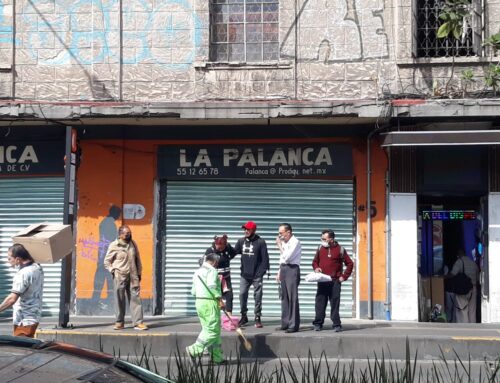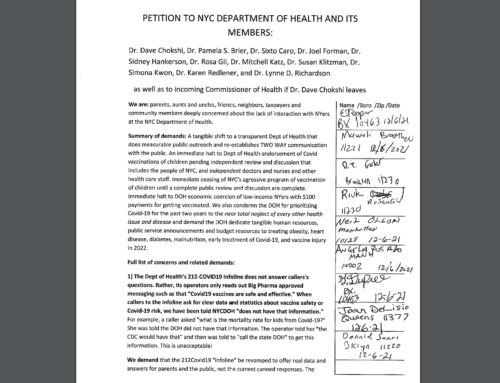by Diane Pagen
There is a visually cool but intellectually ridiculous exhibit going on downtown in New York City until November 15th called Canstruction (canstruction.org). Architects designed a few dozen sculptures made out of thousands of stacked up cans of food. I went to see it on opening day. Everyone likes it, and it’s definitely artsy and impressive. So why is it ridiculous?
Because on posters displayed throughout the exhibit, it says that the purpose of Canstruction is to “stop hunger,” but aside from repeating that one in five children in New York is “food insecure” (charity code word for poor) it omits discussion or even mention of the biggest reason people are hungry anywhere in the U.S.: the dismantling of our cash and food aid programs, and our government’s reneging on its responsibility to govern with policies that assure the basic survival of its citizens.
Hunger in the United States is not absence of food, but an absence of money, and an absence of good social policy to lift incomes up to a level a human being can survive on. In New York, we have a median rent of $3,185 a month but a median income of only $50,711. We need effective income support programs to close the gap and to reverse the suffering. Ironically, the Canstruction exhibit is set up at Brookfield Place, the City’s luxury brand shopping mall, where no one who earns the median NYC income can afford to buy more than a dishtowel.
But Canstruction does not say that government policy has a role in solving the crisis. The exhibit does not address the cause of hunger (really malnutrition) here, or what it will take to end it. The posters don’t mention government policy at all—not even the most obvious one, Food Stamps. Legislators have been making Food Stamps and cash welfare harder to get for more than two decades and have frozen the benefits at 1990’s levels in most states. The current administration has endorsed many states’ push to add work requirements and drug testing to their Food Stamp programs, which has been proven to make aid harder to keep. As a social worker I can say that burdensome paperwork kicks people off of Food Stamps constantly, forcing them to beg and borrow for months before they finally get benefits again. When adults get kicked off of government aid, children don’t eat. Donated food does nothing to stop this.
Yet despite the above, Canstruction says that the way to stop hunger is only for more of us to give money and food to charities and volunteer. If only you’d do more the exhibit says, we could “outrun hunger”—accompanied by a sculpture of a running man; and solve “a whale of a problem”—accompanied by a sculpture of a whale. If you, not your legislators did more, children would not be going without. Hunger is “everyone’s responsibility,” except apparently the legislators who get paid to craft policy.
If Canstruction highlights hunger and poverty with no accompanying rational solutions, then the exhibit is no more than entertainment presented on the backs of poor people, using their despair as a fundraising tool. This does not help poor people.
Hunger has increased because poverty has increased. Decades of aggressive legislative action have reduced income support all around the country. In New York state in 1996, 79 out of every 100 families poor enough to qualify got cash welfare. Today only 43 out of 100 do, and the number helped each year decreases even though the days of making enough income from a job are over.
Food charities don’t need any more money. The one that will receive whatever donations are made to Canstruction, City Harvest, had net assets of $19,000,000 in 2016. The most important thing City Harvest can do now is using their substantial assets to push on the politicians to get sufficient income support directly to people, not raise more money to “rescue food.” At the end of Canstruction, the group will give the 100,000 or so cans to City Harvest. Next year they will do the same. The problem will continue, despite so many cans and so many dollars given to charity.
Canstruction may say that its role was only to create awareness of hunger. It is well meaning but unhelpful. New Yorkers are more than aware. Every day on my way to Manhattan I get asked to help someone buy breakfast. Only people who live in bubbles of privilege, say, people who spend all their time in Park Slope and the Upper East Side, seem unaware or uninterested in people who are going without food.
We shouldn’t use a life threatening crisis like poverty as the basis for a public art project without any responsible discussion or call to action of how to solve it. This exhibit will be up for two weeks and many thousands of people will see it. This is a missed opportunity to call upon our leaders to do their job and create policy that ensures the basic food and other survival needs of people.
If we were able to pay for the Oculus, the conjoined twin of Brookfield Place that also caters to the rich, we can surely fund an increase to cash assistance or more Food Stamps, so the monthly benefit amount is adequate for real human needs. We could also afford to give cash assistance to way more than 43 out of every 100 families living in poverty.
There is still time for its organizers to enhance the exhibit with more thought provoking and policy information so that the exhibit stirs up discussion of policy change and what role reckless policymaking has played in the lives of those the exhibit tells us to help. Canstruction could encourage us to ask legislators to raise Food Stamp benefits or even create a new local cash supplement for New Yorkers. Both of these strategies are doable, we just need to think out of the box. Just decreasing the paperwork requirements put on those enrolled in Food Stamps/SNAP or “Welfare” programs would naturally increase how many people we help while reducing the cost of the programs and providing an economic stimulus that creates jobs. Knowing that Canstruction was calling for new policy to end hunger would make this exhibit a lot more appetizing.







Leave A Comment